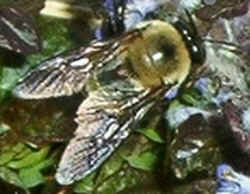 |
American Bumble Bee
Scientific Name: Bombus pennsylvanicus
Family Name: Apidae
Serendipity Ranch
Columbus, North Carolina
 |
The American Bumble Bee is black behind the wings with yellow on abdominal segments 1 - 3. It is found in the United States and southern Canada. Bumble bees are distinguished from Honey Bees and bees in other families by wing venation and other details. [Milne, Lorus and Margery, National Audubon Society Field Guide to North American Insects and Spiders, Alfred A. Knopf, New York, 1980]
Common and well-known insects; orbust, hairy, generally 15 - 25 mm., and black with yellow (rarely orange) markings. 2nd submarginal cell is more or less rectangular and about as long as the 1st, dorsal surface of abdomen is hairy, there is a distinct space between base of the compound eye and base of the mandible (most other bees have mandibles attached very close to the eyes), and hind wings lack a jugal lobe. Most bumble bees nest in or on the ground, often in a deserted mouse nest. Psithyrus species are inquilines, laying their eggs in nests or other bumble bees. Bumble bees are social, and their colonies contain 3 castes: queens, drones (males), and workers (Psithyrus has no worker caste). Colonies are generally annual, the queens overwintering and starting new colonies in the spring. Queens are usually much larger than workers and drones. Bees in the genus Psithyrus do not collect pollen, and their hind tibiae are rounded, dull, and hairy; other bumble bees (which do collect pollen) have the hind tibiae bare, smooth, and shiny. [Borror, Donald J. and White, Richard E., Peterson Field Guide Series: A Field Guide to the Insects of America North of Mexico, Houghton Mifflin Company, Boston, 1970]